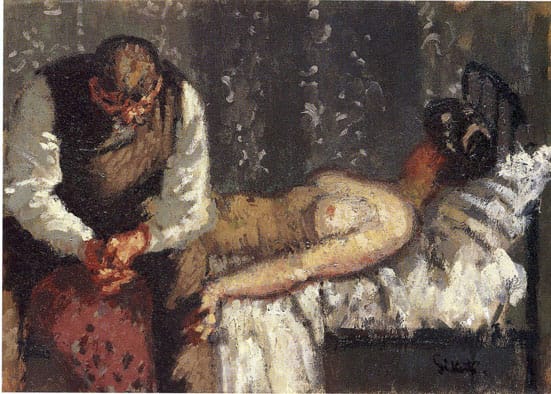As
the Courtauld celebrates its 75th anniversary Artvehicle catches up
with Dr Deborah Swallow, Director of the Courtauld Institute of Art
(www.courtauld.ac.uk).
AM: What celebrations are planned for the Courtauld's 75th anniversary?
DS: We have planned a special year-long calendar of events to celebrate
our 75th anniversary. We have three anniversary exhibitions, focusing
on the works of major artists in our collections: Walter Sickert,
Pierre Auguste Renoir, and Paul Cézanne. There is a special academic
programme focusing on the theme of 'Writing Art History', and in early
July, we are hosting a three-day celebration for students, alumni, and
friends.
AM: How do the Courtauld's dual functions of art gallery and centre for
the study of the history and conservation of art and architecture
operate together?
DS: The Courtauld was founded on the basis that art is best
understood through close examination of the works being studied. Our
students have unique access to works in our collection, and our small
class sizes are designed to encourage discussion amongst students and
the faculty. The founders of the Courtauld also felt it was important
to make our gallery open to the public so that anyone with an interest
in art could benefit from it.
AM: What are the strengths of the Courtauld Gallery's collection?
DS: The Courtauld Gallery's collection spans more than 700 years of art
history. It is an intimate collection of high-quality pieces and has a
particularly strong selection of Impressionist and post-Impressionist
works from the turn of the century, including works by Renoir, van
Gogh, Manet, Monet, Degas, Gauguin, and Matisse.
AM: The Courtauld Gallery is something of a well-kept secret. Do you have plans to raise its public profile?
DS: People do often refer to the Courtauld Gallery as a 'well-kept
secret', but recently we have seen record numbers of visitors coming to
the gallery. We enjoy the fact that more and more people are enjoying
our collection, and our aim is to preserve the quality of the gallery's
offerings and of the exhibitions so that people continue to come back.
AM: What kind of students does the Courtauld Institute attract? Would you like to broaden its appeal?
DS: The Courtauld aims to attract the best students of art
history and conservation from around the world. They come to study the
broadest range of periods and genres, ranging from the medieval to the
contemporary. Courses at the Courtauld help students focus closing in
on the work of art itself while also placing art in its social,
historical and broader artistic context. The resources which our
community has at its disposal are unparalleled. Our Witt and Conway
libraries contain more than three million images and are used by art
professionals in many different areas.
AM: How does the Courtauld Institute disseminate its scholarship and expertise?
DS: The Courtauld mounts a large number of special events and
programmes throughout the year. Its Research Forum hosts international
research events which bring together academics from around the world;
its Public Programmes Department runs special programmes for school
students, evening and summer courses for adults, and lunchtime talks in
the Gallery for the public. The Courtauld Gallery's exhibition
programme brings a range of scholarship and research into the public
domain, our academics curate exhibitions in major galleries and museums
around the world, and the network of Courtauld alumni can be found
working in positions throughout the art world from education and
journalism to museums, galleries, and auction houses.
AM: I really enjoyed the Courtauld's closely focused exhibitions
'Walter Sickert: The Camden Town Nudes' and 'Temptation in Eden Lucas
Cranach's Adam and Eve'. Who is responsible for curating the cohesive
programme of temporary exhibitions? What exhibitions are planned for
2008?
DS: The exhibition programme is led by the Head of the
Courtauld Gallery, and the exhibitions are distinctive in that they are
often curated by Courtauld Gallery curators with Courtauld academic
staff; each exhibition focuses on a single or group of work from the
collections, or arises out of research being carried out in the
Institute.
Our first anniversary exhibition of this academic year has featured the
Camden Town Nudes of Walter Sickert and runs until 20 January. The 2008
programme starts with the exhibition 'Renoir at the Theatre: looking at
La Loge' which runs from 21 February to 25 May and explores the glamour
of theatre going and its social implications to Parisian nightlife. Our
summer exhibition will display for the first time the Courtauld's
complete collection of works by the artist Paul Cézanne and runs from
26 June to 5 October. Cézanne is often described as the 'father of
modern art' and this collection illuminates how he bridges 19th and
20th century art together through his concentration on form rather than
content. In the autumn of 2008 we will be showing the Courtauld's very
significant collection of works by Turner.
AM: What has been your personal experience of working at the Courtauld?
DS: I find the Courtauld an immensely stimulating place to work. There
is an invigorating intellectual life, a tremendous sense of engagement
and an intensity of experience, but a great sense of enjoyment too. All
my colleagues are dedicated to the institution; students who chose us
as a place of study are strongly committed and there is a strong sense
of a Courtauld family among both the permanent staff and the wider
community of students, alumni and friends.
AM: Where would you like to see the Courtauld at its centenary?
DS: Twenty five years from now, we hope to be as relevant as
ever in our fields of interest. The art world is changing rapidly. It
is increasingly globalised and the speed of development is
accelerating. We intend to embrace these new realities while continuing
to be committed to the highest academic excellence.
AM

Walter Richard Sickert
'The Camden Town Murder or What Shall we do for the Rent?' (detail)
c. 1908
Yale Center for British Art, Paul Mellon Fund
(c) Estate of Walter R. Sickert/DACS 2007.